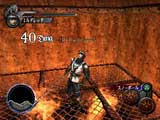 Let’s face it—gaming fans can be one of the toughest
crowds to please. When I picked up Deception III, what I was hoping for was a cross
between Tomb Raider, Final Fantasy, and one of my better D&D campaigns, but I found
that Deception III: Dark Delusion just couldn’t live up to my expectations. This game
had some superior elements, but in the end it left me feeling luke-warm.
Let’s face it—gaming fans can be one of the toughest
crowds to please. When I picked up Deception III, what I was hoping for was a cross
between Tomb Raider, Final Fantasy, and one of my better D&D campaigns, but I found
that Deception III: Dark Delusion just couldn’t live up to my expectations. This game
had some superior elements, but in the end it left me feeling luke-warm.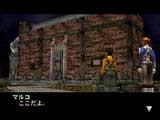 Dark Delusion
is the ongoing saga of the "Legendary Stone," a group of magical stones which,
when brought together from the far corners of the lands in which they have been scattered,
give the owner the power to control time. In this installment, young Reina receives a
brooch with a bluish-green stone for her birthday, and immediately her and adoptive mother
and brother are captured and taken across the sea to be prisoners of evil King Fredrick in
the land of Alendar. The king orders his evil henchman, Miguel, to kill her family before
her eyes, and orders her imprisoned. She manages to escape with the help of the rebellion
and her newfound ability to set traps. This is the only weapon she has to defeat the enemy
and help save herself and the rebellion.
Dark Delusion
is the ongoing saga of the "Legendary Stone," a group of magical stones which,
when brought together from the far corners of the lands in which they have been scattered,
give the owner the power to control time. In this installment, young Reina receives a
brooch with a bluish-green stone for her birthday, and immediately her and adoptive mother
and brother are captured and taken across the sea to be prisoners of evil King Fredrick in
the land of Alendar. The king orders his evil henchman, Miguel, to kill her family before
her eyes, and orders her imprisoned. She manages to escape with the help of the rebellion
and her newfound ability to set traps. This is the only weapon she has to defeat the enemy
and help save herself and the rebellion.
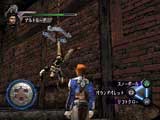 What
first caught my eye and raised my hopes tremendously were the wonderful graphics this game
had. The cinema screens were detailed and extremely intricate, both in foreground and
background. At the beginning of the game, the graphics tended to pixilate during movement,
but that stopped as the cinema screens went on. Most impressive was the fact that the
faces of the characters were completely smooth and rounded in most instances and had a
wonderful, expressive quality.
What
first caught my eye and raised my hopes tremendously were the wonderful graphics this game
had. The cinema screens were detailed and extremely intricate, both in foreground and
background. At the beginning of the game, the graphics tended to pixilate during movement,
but that stopped as the cinema screens went on. Most impressive was the fact that the
faces of the characters were completely smooth and rounded in most instances and had a
wonderful, expressive quality.
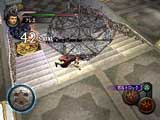 One of
the first problems I noticed was that the narration and character lines were all being
displayed as closed-captioning on the bottom of the screen instead of being spoken, and if
I wanted to know what was happening, I had to take my eyes of the beautiful graphics to
read along. While the back-story of Reina’s life was shown very clearly in the
visuals and could probably have gone without narration, the conversations in King
Fredrick’s court needed the dialogue for full effect, and having to read it while the
character’s lips moved was annoying. Occasionally a character would "say"
something, but it would be left untranslated. The story line was only occasionally cheesy,
(for example, who in their right mind would go to a place called "Castle Agony"
for safety?) but on the whole, interesting and easy to follow.
One of
the first problems I noticed was that the narration and character lines were all being
displayed as closed-captioning on the bottom of the screen instead of being spoken, and if
I wanted to know what was happening, I had to take my eyes of the beautiful graphics to
read along. While the back-story of Reina’s life was shown very clearly in the
visuals and could probably have gone without narration, the conversations in King
Fredrick’s court needed the dialogue for full effect, and having to read it while the
character’s lips moved was annoying. Occasionally a character would "say"
something, but it would be left untranslated. The story line was only occasionally cheesy,
(for example, who in their right mind would go to a place called "Castle Agony"
for safety?) but on the whole, interesting and easy to follow.
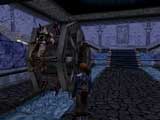 The
sound effects in Deception III were fairly weak, the enemies only emitting noises as they
died (and not really interesting ones at that) and the sound of traps activating becoming
quickly repetitive. What made this element less of a problem was the wonderful musical
score in the background throughout the game. The orchestration varied from harrowing chase
music to haunting, melancholy strains, and was never too repetitive or intrusive. If I
could have sat back and listened to the music and watched the cinema screens (with
dialogue, of course) I could have been awestruck and entertained for hours. But of course,
gameplay awaited.
The
sound effects in Deception III were fairly weak, the enemies only emitting noises as they
died (and not really interesting ones at that) and the sound of traps activating becoming
quickly repetitive. What made this element less of a problem was the wonderful musical
score in the background throughout the game. The orchestration varied from harrowing chase
music to haunting, melancholy strains, and was never too repetitive or intrusive. If I
could have sat back and listened to the music and watched the cinema screens (with
dialogue, of course) I could have been awestruck and entertained for hours. But of course,
gameplay awaited.
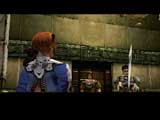 On
the positive side, the movement in this game was smooth and easy to learn, and the
controller extremely responsive. The camera was placed behind and slightly above Reina and
was quick to follow her movement. The game started out with instructional elements in
early battles (which really made the training mode, or the "trap license mode"
as they called it, unnecessary), and the goals of each section were clearly stated so
there was never any confusion about what should be done. The traps were easy to learn how
to set and evolved in power and complexity as the game continued. The interlude cinema
screens both advanced plot and contained information on how "trapping" could be
handled more effectively. Map screens were available for pre-planning, and the rooms were
interesting and varied. Other screens also gave data for the attacking enemy (his or her
stamina, speed, ability to detect traps, etc.) and for your own status as well. All of
these elements together set me up for a pretty potent experience. So why was I left
deflated?
On
the positive side, the movement in this game was smooth and easy to learn, and the
controller extremely responsive. The camera was placed behind and slightly above Reina and
was quick to follow her movement. The game started out with instructional elements in
early battles (which really made the training mode, or the "trap license mode"
as they called it, unnecessary), and the goals of each section were clearly stated so
there was never any confusion about what should be done. The traps were easy to learn how
to set and evolved in power and complexity as the game continued. The interlude cinema
screens both advanced plot and contained information on how "trapping" could be
handled more effectively. Map screens were available for pre-planning, and the rooms were
interesting and varied. Other screens also gave data for the attacking enemy (his or her
stamina, speed, ability to detect traps, etc.) and for your own status as well. All of
these elements together set me up for a pretty potent experience. So why was I left
deflated?
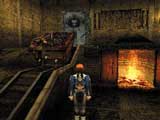 The
answer is fairly simple—the action possibilities were limited and extremely
repetitive, and most importantly, they were not that challenging. When you entered a new
level (or Chapter setting) you were faced with new enemies which, although they had
different abilities, acted in mostly the same way and you were expected to defeat them in
mostly the same way that you had before. Occasionally the environment lent new and
interesting ways to deploy your traps, but for the most part, after the third or fourth
level, you had always "been there—done that." You also set your traps on a
separate grid screen, so when you returned to the action, the traps were already in place
and you didn’t get to see Reina actually set them. They magically appeared and were
activated with a wave of her hand. I can’t help but compare this against Goldeneye
for the Nintendo, where Bond can be seen setting and deploying traps and a great deal of
stealth and cunning is needed to defeat the enemies, or even D&D games where
there’s more to life than melee combat. Deception never really pushed the options for
varied gameplay or challenged me to use much of my intellect to defeat the enemy. It
focused on merely figuring out which combination of traps and power emblems would be most
effective in each circumstance, and it wasn’t varied enough to stay interesting for
long.
The
answer is fairly simple—the action possibilities were limited and extremely
repetitive, and most importantly, they were not that challenging. When you entered a new
level (or Chapter setting) you were faced with new enemies which, although they had
different abilities, acted in mostly the same way and you were expected to defeat them in
mostly the same way that you had before. Occasionally the environment lent new and
interesting ways to deploy your traps, but for the most part, after the third or fourth
level, you had always "been there—done that." You also set your traps on a
separate grid screen, so when you returned to the action, the traps were already in place
and you didn’t get to see Reina actually set them. They magically appeared and were
activated with a wave of her hand. I can’t help but compare this against Goldeneye
for the Nintendo, where Bond can be seen setting and deploying traps and a great deal of
stealth and cunning is needed to defeat the enemies, or even D&D games where
there’s more to life than melee combat. Deception never really pushed the options for
varied gameplay or challenged me to use much of my intellect to defeat the enemy. It
focused on merely figuring out which combination of traps and power emblems would be most
effective in each circumstance, and it wasn’t varied enough to stay interesting for
long.
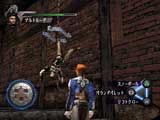 When
the main "story mode" fell down for me, I went in search of other options in the
game to keep my attention. I found the "expert mode," but realized fairly
quickly they had merely upped the stakes by putting in a time limit for success. While
this was challenging, it still was not varied enough to sustain my interest for long.
When
the main "story mode" fell down for me, I went in search of other options in the
game to keep my attention. I found the "expert mode," but realized fairly
quickly they had merely upped the stakes by putting in a time limit for success. While
this was challenging, it still was not varied enough to sustain my interest for long.
The last thing that struck me as odd was the rating for this game. When I see a mature
rating, I have certain expectations (call it my dark side rearing its ugly head, if you
will). Although when enemies died they dropped into a pool of blood, there were no overly
detailed depictions of violence. Most of the violent acts in the cinema screens were no
worse than you might see on Xena during prime-time, and the hints of sex or brutality were
just that—hints. I guess maybe I was looking for more bang for my mature buck.
I think this game has tons of potential, and it’s a great rent if only for the
brilliant graphics and the musical score. Who knows, you might have a greater tolerance
for repetition than I had, and if that’s the case, you’ll probably love this
one. But for now, I’ll wait with baited breath for Deception IV.

 Let’s face it—gaming fans can be one of the toughest
crowds to please. When I picked up Deception III, what I was hoping for was a cross
between Tomb Raider, Final Fantasy, and one of my better D&D campaigns, but I found
that Deception III: Dark Delusion just couldn’t live up to my expectations. This game
had some superior elements, but in the end it left me feeling luke-warm.
Let’s face it—gaming fans can be one of the toughest
crowds to please. When I picked up Deception III, what I was hoping for was a cross
between Tomb Raider, Final Fantasy, and one of my better D&D campaigns, but I found
that Deception III: Dark Delusion just couldn’t live up to my expectations. This game
had some superior elements, but in the end it left me feeling luke-warm.